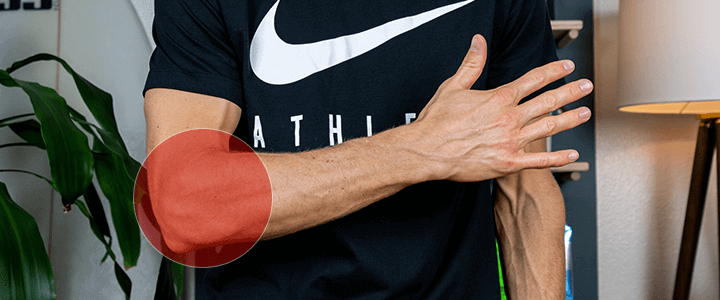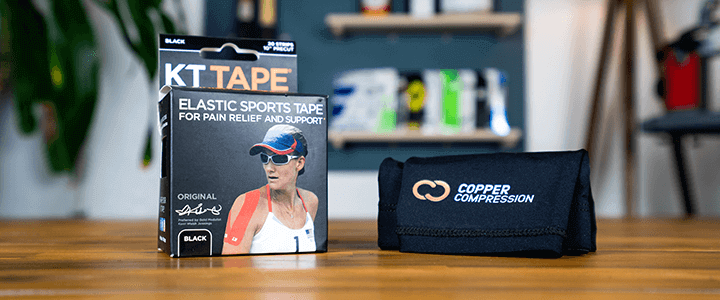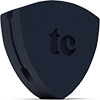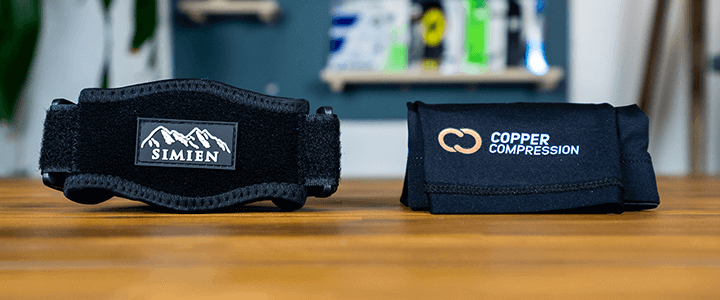Check out my custom vibration dampener
Best Tennis Elbow Braces, Straps, and Sleeves
In-depth Guide
We hope you love this article. Just so you know, TennisCompanion may collect a small share of sales from the links on this page to help keep this site running. Learn more.
If you’re suffering from tennis elbow, then you might be considering the purchase of a brace, strap, or compression sleeve to help alleviate discomfort associated with this frustrating condition.
For many, they provide welcome relief, and there’s a wide selection available to consider. However, before you buy one, it pays to have a general understanding of how these products work, including how to wear them for the best possible results.
In this guide, we’ll provide you with helpful information to consider before selecting a brace, strap, or sleeve, including our picks for some of the best and most popular options available.
| Product | Type |
| Bodyprox | Brace / Strap |
| Sleeve Stars | Brace / Strap |
| Simien | Brace / Strap |
| Pro Band Bandit | Brace / Strap |
| Senteq | Brace / Strap |
| Mueller | Brace / Strap |
| Futuro | Brace / Strap |
| Ace | Brace / Strap |
| Kunto | Sleeve |
| Tommie Copper | Sleeve |
| Venom | Sleeve |
| Simien | Sleeve |
Disclaimer: This guide is for information purposes only and is not intended as a substitute for professional medical advice, diagnosis, or treatment. Always seek the guidance of your doctor or other qualified health professional with any questions you may have regarding your health or a medical condition.
Article Contents
Click below to jump to a section
Tap below to jump to a section
Proper Diagnosis
What is Tennis Elbow?
How Braces Work
How to Wear a Brace
How Long to Wear
Elbow Brace Alternatives
Tennis Specific Considerations
12 Best Elbow Braces
Where to Buy
New to TennisCompanion?
Create a free account and explore my latest videos below
Proper Diagnosis

The effective treatment of tennis elbow begins with a proper diagnosis by a physician or healthcare professional, so if you haven’t already, we’d encourage you to start there.
As described by John Hopkins Medicine, “your healthcare provider can usually diagnose your tennis elbow by a physical exam.”
Of course, you don’t need a diagnosis to purchase a tennis elbow brace from your favorite retailer, but speaking with a professional will help ensure you’re on the right track and properly handling the issue.
A quick discussion can also help rule out any other potential causes for your discomfort that one could mistake as tennis elbow.
If you haven’t already, a few healthcare professionals you might consider speaking with include a primary care physician, nurse practitioner, physical therapist, chiropractor, or acupuncturist.
What is Tennis Elbow?

According to the American Academy of Orthopaedic Surgeons (AAOS), tennis elbow, also referred to as lateral epicondylitis, “is a painful condition of the elbow caused by overuse.”
More specifically, the AAOS goes on to state that, “Tennis elbow is inflammation or, in some cases, microtearing of the tendons that join the forearm muscles on the outside of the elbow. The forearm muscles and tendons become damaged from overuse — repeating the same motions again and again. This leads to pain and tenderness on the outside of the elbow.”
Although tennis players are susceptible to this condition because of overuse that can occur from swinging a racquet repeatedly, especially hitting backhands, they’re far from the only people who suffer from it.
Anyone who works or participates in activities that demand repetitive use of their fingers, wrist, and forearm, like tennis, can be susceptible.
Closely related sports such as racquetball, pickleball, squash, and badminton are more apparent offenders. However, occupations such as painters, plumbers, musicians, assembly works, and cooks are further examples of the types of people that may find themselves at risk.
How Tennis Elbow Braces Work

A tennis elbow brace, also referred to as a counterforce brace, wraps around an individual’s forearm near the source of pain to provide relief.
According to an excerpt from The Sports Medicine Resource Manual, “The most common orthosis for lateral elbow pain is the counterforce brace. The proposed mechanism for this brace is the dissipation of the forces away from the injured tissue to the surrounding noninjured area.”
In effect, a brace, which often features a firm pad, applies consistent pressure to a targeted location on a person’s arm to spread or redistribute force or tension to healthy tissue, thus relieving pain.
Although there are many different designs available for tennis elbow braces or straps, the general premise for all of them is the same, so your personal preference will come into play when selecting one.
With that in mind, here are a few things to look out for when purchasing a tennis elbow brace to ensure it works effectively.
Size
For a tennis elbow brace to adequately apply pressure to your arm, you’ll need to ensure you find one that’s the proper size.
Luckily, most tennis elbow braces offer adjustable straps with velcro to increase or decrease the size for the perfect fit. However, you may still need to select a size in some cases, which will require you to measure your arm’s circumference to determine which option is best.
If you purchase a brace that doesn’t fit properly, we’d encourage you to return it and search for another better-suited product. With the number of available options, there’s no sense in settling.
Comfort
When you buy a brace for tennis elbow, you want to make sure it’s comfortable to wear and stays put on your arm, so it’s helpful to pay attention to the materials used and closely read reviews from past customers that can give clues to a product’s comfort.
Remember, you’ll need to tighten the brace sufficiently to achieve relief, so details as nuanced as the stitching and how the product lies against your skin are useful to consider for the best results.
Durability
You won’t wear a tennis elbow brace 24-hours a day; you’ll be taking it on and off periodically as needed.
With that in mind, it pays to find a product that’s proven its durability with prior customers who have shared their experience. As an example, many products use velcro, which is entirely sufficient. However, it may quickly wear if it’s low quality and make it difficult to achieve a snug fit.
How to Wear a Tennis Elbow Brace

In many cases, products will include detailed instructions for their use, so we’d encourage you to follow those as a starting point. Alternatively, a qualified healthcare professional can show you how to wear a brace.
With that said, many products include lackluster documentation, so we’ll cover how to wear a popular brace design.
1.) Place the Brace Over Your Hand

Undo the velcro for your brace so you can easily slide it over your hand and onto your arm. If your strap has a pad for increased pressure, make sure it’s facing inside toward your arm as you slide it over your hand.
2.) Slide the Brace Up Your Forearm

Slide the brace up your forearm until you reach a point roughly 1-3 inches or 3-8 centimeters from the tip of your elbow.
It should be far enough away from the crease of your elbow so that you can move your arm freely without it rubbing unnecessarily or restricting movement.
3.) Position the Brace

Position the brace between the top and outside edge of your forearm – if your brace has a pad, you’ll want to make sure it targets that location.
You may find it helpful to move your fingers up and down and watch the muscles wiggle at your arm’s outer edge. You’ll want the pad to cover those muscles you see moving.
4.) Tighten the Brace

Pull the strap snug and secure the velcro. When you squeeze or tighten your fist, you should feel pressure where you placed the brace.
Again, it should be snug but not too tight. If you have any numbness, tingling, or discoloration in your hand, then loosen the strap.
5.) Adjust the Brace as Needed

You may need to adjust the strap by rotating it back and forth or up and down your forearm slightly. As you change the brace’s position, make sure you undo the velcro and retighten it so that it’s snug once again.
How Long to Wear a Tennis Elbow Brace

A common and practical question surrounding the use of a tennis elbow brace is how long to wear it.
According to Kaiser Permanente, “You may need to wear it for up to 6 weeks.” However, they go on to suggest further that you should “wear it only during activities that involve repetitive gripping and grasping. Avoid wearing it when your arm is at rest.”
As a tennis player, if you only experience discomfort while hitting, you should only need to wear it during that time.
As another point of reference, the American Academy of Family Physicians (AAFP) suggests, “Use of an inelastic, nonarticular, proximal forearm strap may decrease pain and increase grip strength after three weeks. Bracing for up to six weeks also may improve the patient’s ability to perform daily activities.”
In other words, it can take time to realize the benefits of wearing an elbow brace, so you may need to be patient.
For more specific guidance, always check in with your physician or a qualified healthcare provider for a personalized recommendation.
Elbow Brace Alternatives

If you’re on the hunt for a new tennis elbow brace or you didn’t find the relief you were hoping for, then it can be helpful to become familiar with a few alternatives at your disposal.
Tennis Elbow Compression Sleeves

Like braces, compression sleeves may provide the necessary support for people suffering from tennis elbow.
According to the National Institute of Health, “the application of compression clothing may aid in the recovery of exercise induced muscle damage, although the findings need corroboration.”
These sleeves slide onto a person’s arm, and their tight fit ensures proper compression. It’s worth noting that you’ll need to measure your arm to make sure you purchase the appropriate size and that different sleeves will provide varying degrees of compression.
Furthermore, there are a few different types of sleeves available for tennis elbow that you might consider:
- Standard Sleeve: Your standard sleeve won’t have any extra bells and whistles – it’s a simple sleeve that slides over your arm to provide compression. The Kunto Fitness Compression Sleeve is an excellent example of a standard compression sleeve.
- Copper Sleeve: Some companies infuse their sleeves with copper, an antimicrobial material that can also reduce odor and extend the product’s life. Tommie Copper offers a range of copper-infused products, including a compression sleeve.
- Sleeve with Elastic Support: Some sleeves provide compression but take things a step further and incorporate elastic support to tighten the area over your forearm for added support. Venom Sports offers this type of sleeve.
- Sleeve with Pads: Another type of tennis elbow compression sleeve that you may come across sews pads into the fabric to help target the area of your arm where you may be experiencing discomfort. The Simien Elbow Brace Compression Sleeve is one example.
Some people may find that sleeves offer greater comfort and a more secure fit than a tennis elbow brace. Regardless, a tennis elbow sleeve might be an alternative worth considering.
Kinesiology Tape

Some players may find promising results using kinesiology tape for tennis elbow, which many athletes use to relieve pain and add support.
In the 1970s, Dr. Kenzo Kase invented kinesiology tape. According to his website, “Kinesio tape alleviates discomfort and helps fluid drainage by microscopically lifting the skin. This lifting affect reduces pressure and inflammation and allows for fluids to flow in and out of the Kinesio taping area.”
Unfortunately, research backing the efficacy of kinesiology tape is limited. Some studies, such as a study published in the Journal of Orthopaedic & Sports Physical Therapy (JOSPT), suggest that kinesiology tape “appears to be no more efficacious than sham taping.”
Nevertheless, many athletes report improvements using kinesiology tape, and KT Tape offers detailed instructions for applying their tape for improving tennis elbow, so it’s a viable option worth exploring.
Here are a few reputable kinesiology tape brands that you might consider researching if you’d like to experiment with this product.
- Kinesio Tape
- KT Tape
- Rock Tape
Like braces, the core function of each of these tapes is the same, but many people develop a preference.
Tennis Specific Considerations

Although many players find tennis elbow braces, straps, and sleeves useful, we’d be remiss without discussing a few tennis-specific implications of tennis elbow.
As you evaluate different products, we’d encourage you to consider how the following may impact your tennis elbow.
Racquet Stiffness
One of the many attributes or specifications associated with tennis racquets is stiffness, or how much a racquet flexes when hitting.
All else equal, a stiffer racquet will impart more shock and vibration to a player’s arm, which over time can lead to discomfort and contribute to or intensify pain from tennis elbow.
A specialized machine, such as the Babolat Racquet Diagnostic Center, measures racquet stiffness by fixing the handle of a racquet in place and applying pressure to its tip to come up with a numeric value, also referred to as a racquet analysis or RA rating.
RA ratings typically fall somewhere between 50 and 85, with lower numbers indicating a more flexible racquet and higher numbers a stiffer frame. A rating between 67 and 85 is on the higher end of the spectrum and may offer less comfort for many players.
As a result, if you’re suffering from tennis elbow, we’d encourage you to consider the racquet your using as a contributing factor. Check out our guide to learn more about tennis racquet stiffness.
Grip Size
When players develop tennis elbow, they may experience pain associated with gripping their racquet’s handle since the muscles involved are required to hold or grip an object.
With this in mind, we always encourage players to double-check that they’re using the correct grip size.
A grip that’s too small can cause a player to overcompensate and grip tighter to keep the racquet stable and prevent it from twisting, while a large grip can be cumbersome, challenging to hold, and place undue stress on your hand, wrist, and arm.
Luckily, it’s easy to find the correct grip size. Plus, if your grip is too small, there are reasonable steps you can take to increase its size. It’s more challenging to decrease a grip size, but there are some steps you can take, such as purchasing a thinner replacement grip.
Strings & Tension
Another factor that can increase discomfort associated with tennis elbow is a player’s tennis strings or, more specifically, the type of strings, the tension you string your racquet, and how often you replace them.
Different tennis strings provide varying degrees of comfort, so we’d encourage you to experiment with softer options.
If you can afford them, natural gut tennis strings offer some of the highest levels of comfort. However, synthetic multifilament strings are another excellent option to consider and perform well too.
For most players experiencing arm discomfort, we encourage them to steer clear of polyester strings, which are the stiffest and therefore the harshest on a player’s arm. At the very least, we encourage players to consider stringing polys as part of a hybrid string setup for added comfort.
However, beyond the type of strings, the tension you select when stringing your racquet can also play a role. To increase comfort, players can lower the tension of their strings by a few pounds, which reduces stiffness. Dropping tension by roughly 2-5 pounds is a good place to experiment for most players.
However, keep in mind that you’re also going to increase power when you reduce tension, so it may take a few string jobs to find a sweet spot.
Finally, how often you string can also impact comfort. Over time, strings lose their resilience and go dead. As a result, their performance declines, including their ability to absorb shock and vibration to offer a comfortable hitting experience.
With this in mind, we encourage players to restring their racquets regularly to maintain their performance.
Technique
Although many players might not want to admit it, their technique can influence their comfort and propensity to develop tennis elbow.
Trained tennis instructors can easily spot flaws in a player’s technique that may contribute to discomfort, so signing up for a few lessons is an excellent approach to verify you’re on the right track.
12 Best Elbow Braces, Straps, and Sleeves
There’s a wide array of tennis elbow braces on the market, so we’ve hand-picked a diverse collection of some of the best to help you narrow your options from brands you can trust.
Bodyprox Brace
A long-time favorite, the Bodyprox tennis elbow brace is one of the most popular elbow braces available. It comes in one size, which is adjustable with hook and loop velcro closure so that you can achieve the perfect fit.
It offers a compression pad sewn directly into the brace, which is a bit wider than the rest of the strap for greater coverage when you’re adjusting it to find the ideal placement. Plus, the material is a soft neoprene to help ensure comfort against your skin.
The Bodyprox tennis elbow brace is black on top, where you’ll find their logo, but blue underneath. Each purchase comes with two elbow braces.
| Count | 2 Pack |
| Size | One Size |
| Colors | Black & Blue |
| Materials | Neoprene, Velcro |
Sleeve Stars Brace
With a very similar design to Tomight, the Sleeve Star brace is another one size fits most option for a strap to manage tennis elbow.
With your purchase, you’ll only get one brace. However, to make sure it fits well, Sleeve Stars includes three different strap sizes, ideal if your arm is smaller or larger than most. According to the company, it will fit any arm between nine and 23 inches.
The material is comfortable nylon and neoprene, which has the added benefit of absorbing sweat, and they’ve paid extra special attention to the stitching for a durable product that lasts. Furthermore, Sleeve Stars sews a pad into the brace for targeted compression.
As for colors, its simple black design is punctuated by its circular logo, which is stitched directly into the brace’s top.
As a bonus, Sleeve Stars includes an instruction manual and elbow pain ebook, which you might find useful.
| Count | 1 Pack |
| Size | One Size |
| Colors | Black |
| Materials | Nylon, Neoprene, Velcro |
Simien Brace
Another option that offers a similar design to Tomight and Sleeve Stars is the Simien tennis elbow brace. When you make your purchase, it’s worth noting you’ll receive two straps and a bonus wrist sweatband too.
Although the brace only comes with a single size strap, it should fit the vast majority of arms with a velcro closure.
For materials, the brace primarily uses nylon, and it comes black. To make sure you know how to use the brace, Simien also offers an ebook. It covers how to use the strap and includes additional online resources that you may find useful in dealing with tennis elbow.
| Count | 2 Pack |
| Size | One Size |
| Colors | Black & Blue |
| Materials | Nylon, Velcro |
Pro Band Bandit Brace
The Bandit brace offers an entirely different design than the others we’ve covered up until this point. Although it uses velcro to tighten the brace like many others, there are two distinct plastic pieces.
Each piece has foam padding for comfort against your arm, and the velcro strap connects them. According to Pro Band’s website, it’s a one size fits most design, but customers can special order an extended length strap if needed – 20 inches instead of 18.
With your purchase, you’ll receive one brace. Furthermore, the Bandit Brace is white with black bands, and they print their distinct logo directly on the strap.
| Count | 1 Pack |
| Size | One Size |
| Colors | White & Black |
| Materials | Unknown |
Senteq Brace
The Senteq tennis elbow brace offers a slightly wider design than some of the others we’ve covered, which may provide more generous coverage for some players. It’s another one size fits most option, which you can adjust to different arm sizes with its elastic velcro strap.
On the inside of the strap, you’ll find a gel pad for extra targeted compression, and the neoprene fabric is breathable. Regardless of the activity, it’s an excellent option to consider.
The Senteq strap is grey, and it comes in a one pack, but it’s also available in a two-pack if you’d like to purchase an extra.
| Count | 1 Pack |
| Size | One Size |
| Colors | Grey |
| Materials | Neoprene |
Mueller Brace
For a simple-looking yet effective strap, you might consider the Mueller tennis elbow brace. Like many other available options, it comes in one size that should fit the vast majority of players with arm sizes that measure 7-14 inches or 17-35 centimeters around the elbow.
The Muller brace comes in black and beige, and you can purchase it with or without a gel pad for targeted compression.
| Count | 1 Pack |
| Size | One Size |
| Colors | Black, Beige |
| Materials | Unknown, Double-Knit |
Futuro Brace
Futuro is a well-known brand that offers a few different tennis elbow braces, but our favorite is their custom pressure elbow strap.
Like most elbow braces, it slides onto your arm, and you apply tension with a velcro strap. There’s also a gel cushion underneath for targeted pressure, but that’s where the similarities end.
Once you tighten the brace, there’s a dial on the strap for increasing the pressure against your arm. Turn the dial clockwise to increase pressure or counterclockwise to decrease it for optimal comfort and support.
According to Futuro, it offers up to three times more pressure under the pad when using the dial than the strap alone. They’ve also paid close attention to comfort to ensure the edges of the brace are soft.
When you purchase the Futuro Custom Pressure Elbow Strap, you’ll receive one brace, which is all black. As far as sizing goes, it should fit arms from 7-14 inches or 17-35 centimeters.
Overall, it’s a unique design and well worth checking out.
| Count | 1 Pack |
| Size | One Size |
| Colors | Black |
| Materials | Unknown |
Ace Brace
If you’re looking for a bare-bones tennis elbow brace, then ACE might have what you need. They offer a simple black brace with a velcro strap for accommodating arms from 7-13 inches or 17-33 centimeters.
Included with the brace is an air cushion for targeted compression, which you can remove if you don’t prefer to use it.
According to ACE, the materials are breathable for comfort. Furthermore, it comes as a one-pack.
| Count | 1 Pack |
| Size | One Size |
| Colors | Black |
| Materials | Unknown |
Kunto Sleeve
If you’re unsure about the available tennis elbow braces and would like to try a compression sleeve instead, then the Kunto has an excellent option.
It comes in five different sizes, so you’ll have to measure your arm before ordering, but it’s an important step to ensure the right fit.
It’s pretty straightforward – measure your arm at the elbow joint. Here is how the sizing works for the sleeve:
- X-Small: Under 4.25″
- Small: 4.25″ – 9.0″
- Medium: 9.0″ – 13.5″
- Large: Over 13.5-17″
- X-Large: Over 17″
According to Kunto, their sleeve offers a true fit with four-way stretch to avoid slippage and ensures it stays put for reliable support.
Kunto makes their sleeves with nylon, spandex, and rubber, and it comes in three different colors.
| Count | 1 Pack |
| Size | XS, S, M, L, XL |
| Colors | Black, Grey, Orange | Weight, Grey, Black | Beige |
| Materials | Nylon, Spandex, Rubber |
Tommie Copper Sleeve
For a unique twist on compression sleeves for tennis elbow, this option from Tommie Copper provides the same support you’ll get from other sleeves, but they infuse the fabric with their Copper Znergy technology.
According to Tommie Copper, Copper Zynergy eliminates odor-causing microbes and won’t wash out, so you’ll get this benefit for as long as you own and wear the sleeve.
It comes in five different sizes and is available in a range of colors that include black, blue, grey, nude, and white.
| Count | 1 Pack |
| Size | S, M, L, XL, XXL |
| Colors | Black, Blue, Grey, Nude, White |
| Materials | Polyester, Lycra Spandex |
Venom Sleeve
The Venom Sleeve is a cross between a tennis elbow brace and sleeve, which offers both solutions integrated into a single product.
Once you slide the compression sleeve onto your arm, there’s an elastic velcro strap that you tighten around your forearm for added support. It also has the benefit of preventing the sleeve from slipping.
The elastic strap is extra wide for added support and coverage, and the sleeve’s material is lightweight and breathable for comfort.
The Venom Sleeve comes one to a pack and is available in five different sizes. Its color is black and white.
| Count | 1 Pack |
| Size | S, M, L, XL, XXL |
| Colors | Black & White |
| Materials | Unknown |
Simien Sleeve
Another unique compression sleeve option for tennis elbow comes from Simien, which incorporates gel pads for targeted pressure.
The Simien Sleeve slides onto your arm, similar to other sleeves, but once you have it pulled over your elbow, you’ll position the gel pads to target tennis and golfers elbow effectively.
If you’re intrigued by compression sleeves, but you’re not convinced they’ll offer the pressure and support you desire, then you may find what you’re looking for with this product.
The Simien Sleeve comes in one multi-color design and is available in four different sizes ranging from small to extra large.
| Count | 2 Pack |
| Size | S, M, L, XL |
| Colors | Black, Grey, Blue |
| Materials | Unknown |
Where to Buy
Tennis elbow is a common condition, so you’ll find a wide variety of retailers carrying an assortment of options.
Here are some places that usually carry them:
- CVS
- Walgreens
- Walmart
- Target
- Amazon
One benefit to shopping at your local store is that you can pull the brace out of the box to try it on and see if it fits appropriately. It’s also a great way to become familiar with braces before buying one online.
However, local retailers tend to have a small selection in our experience, so if you’re looking for the most comprehensive selection, you’ll likely want to do your shopping online.
Wrapping Up
If your experiencing arm discomfort, we’d strongly encourage you to get in touch with your physician or another qualified health professional so they can accurately diagnose your symptoms.
From there, you may find that tennis elbow braces, straps, and sleeves serve as an effective means for improving comfort and dealing with pain.
If you play tennis, we also encourage you to consider how your racquet, strings, tension, and technique might be contributing to your tennis elbow.
Hopefully, you’ve found this guide useful for exploring some of the best braces available for tennis elbow, or at the very least, it helps point you in the right direction. Cheers to your health!
Home > Gear > Braces & Sleeves > Tennis Elbow Braces
Play Better Tennis
Improve your game alongside our community of tennis players
Why join?
Discussion Boards
Join the conversation with other members of the community.
5 Point Friday
Read our weekly recap of the 5 most interesting things we dig up in tennis.



Leave a Reply
Want to join the discussion?Feel free to contribute!